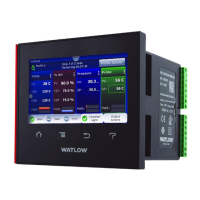Watlow F4T • 82 • Chapter 5 Function Reference
F4T Functions Described
The controller is customized by connecting function blocks (FB) as needed for the application.
A transmitter of one function is commonly connected to a receiver of another using Com-
poser's function block diagram editor. The connections between blocks, referred to as signals,
carry information from one function block to another.
Each signal carries three pieces of information:
1. Value
• The value is either analog
(floating point numbers) or
digital (on, off, true or false).
Most function blocks expect
a specific type of value to be
received at each receiver and produce a specific type of value at each transmitter.
Depending on the context, the value of a digital signal may be thought and spoken of
in various terms. The table below lists the various terms that occur in the various con-
texts.
Analog Value Digital Values Logic *Active Signal Parameter Settings
0% Off False Low
100% On True High
* When the state of a digital signal that triggers an action is congurable, the values are
referred to as Active and Inactive and a parameter is provided for choosing which state
triggers the action. As an example, if the TUN receiver in the graphic above is connected
to a digital device, the Loop 1 parameter "Initiate Autotune Active Level" (High or Low)
will determine when tuning occurs.
2. Units
• An analog signal can be in units of absolute or relative temperature (Celsius or Fahr-
enheit), percent power or relative humidity. Values may have no units or unspecified
units, indicated as process. Digital signals have no units associated with them.
Units Description
Absolute
Temperature
The value is a temperature on the Celsius or Fahrenheit scale. For example,
33° F as an absolute temperature is one degree above the freezing point
of water. An absolute temperature can be used as a set point or compared
with other temperatures to determine which is hotter or colder
Relative
Temperature
The value is a relative number of degrees, not an absolute temperature.
For example, the difference between the two measured temperatures, 120°
C and 100° C is 20 degrees, but it is not the temperature 20° C. A relative
temperature is appropriate for use as a calibration offset or a deviation
alarm set point
Relative
Humidity
The value is a measurement of percent relative humidity (%RH)
Power
The value is a percentage with 100% representing full power and 0% repre-
senting no power
Process
The value is in units of measure other than degrees Fahrenheit, degrees
Celsius or relative humidity
None The value is a pure number without units

